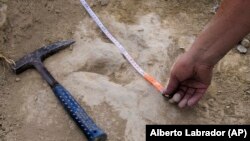New research on dinosaur footprints unearthed in Spain adds to growing evidence that a dinosaur that was genetically similar to the Tyrannosaurus rex was extremely agile. The Tyrannosaurus rex was a very large meat-eating dinosaurs that was not agile.
The findings were published on December 9 in “Scientific Reports,” which covers natural sciences. The findings announced the existence of sets of fossilized dinosaur footprints that prove the dinosaur could move quickly.
These footprints join other sets found in Utah and Texas. One of the sets there shows dinosaurs running at speeds over 48 kph. The Spanish footprints showed speeds of nearly 45 kph.
To figure out the running speed, scientists measured the length of the footprints and then considered the height of the place where the dinosaur’s legs meet the body, or the hip. They also needed to consider the distance between one footprint and another on the same foot.
All the known sets of prints that show speed come from a family of dinosaurs called theropods. These carnivorous, or meat-eating, dinosaurs stood on two legs and could not fly. They are like the famed velociraptor, a dinosaur seen in many famous movies.
The researchers estimated that the animal that created the most recent set of footprints was probably 1.5 to 2 meters tall and 4 to 5 meters long from mouth to tail.
Scientists think there may be faster dinosaurs, but these footprints have been easier to find. The footprints are known as tracks when there are one or more long sets.
“Behavior is something very difficult to study in dinosaurs,” said lead writer Pablo Navarro-Lorbés of the University of La Rioja. “These kind of findings are very important, I think, for improving that kind of knowledge.”
Scientists usually predict dinosaur behavior through computer modeling of the animals’ movement. Physical examination of fossilized footprints confirmed the results.
These are “clearly active, agile animals,” said Smithsonian paleontologist Hans Sues, who was not part of the study.
I’m Gregory Stachel.
Emma H. Tobin reported this story for The Associated Press. Gregory Stachel adapted it for VOA Learning English. Susan Shand was the editor.
____________________________________________________________
Words in This Story
dinosaur – n. one of many reptiles that lived on Earth millions of years ago
agile – adj. able to move quickly and easily
fossil – n. something (such as a leaf, skeleton, or footprint) that is from a plant or animal which lived in ancient times and that you can see in some rocks
tail – n. the part of an animal's body that extends from the animal's back end
paleontology – n. the science that deals with the fossils of animals and plants that lived very long ago especially in the time of dinosaurs








